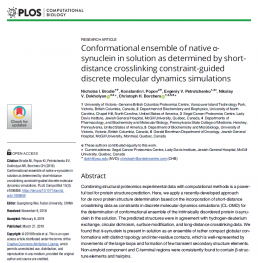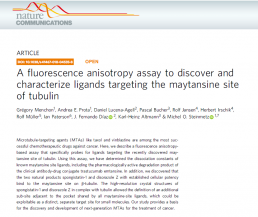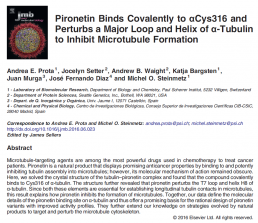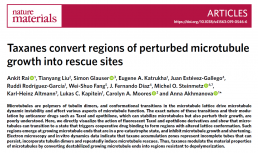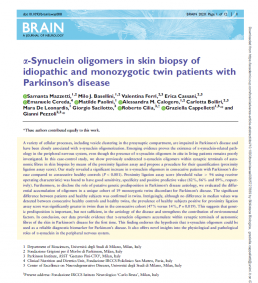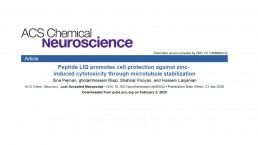Conformational ensemble of native αsynuclein in solution as determined by shortdistance crosslinking constraint-guided discrete molecular dynamics simulations
Combining structural proteomics experimental data with computational methods is a powerful tool for protein structure prediction. Here, we apply a recently-developed approach for de novo protein structure determination based on the incorporation of short-distance crosslinking data as constraints in discrete molecular dynamics simulations (CL-DMD) for the determination of conformational ensemble of the intrinsically disordered protein α-synuclein in the solution. The predicted structures were in agreement with hydrogen-deuterium exchange, circular dichroism, surface modification, and long-distance crosslinking data. We found that α-synuclein is present in solution as an ensemble of rather compact globular conformations with distinct topology and inter-residue contacts, which is well-represented by movements of the large loops and formation of few transient secondary structure elements. Non-amyloid component and C-terminal regions were consistently found to contain β-structure elements and hairpins.
https://journals.plos.org/ploscompbiol/article/file?id=10.1371/journal.pcbi.1006859&type=printable
A fluorescence anisotropy assay to discover and characterize ligands targeting the maytansine site of tubulin
Microtubule-targeting agents (MTAs) like taxol and vinblastine are among the most successful chemotherapeutic drugs against cancer. Here, we describe a fluorescence anisotropybased assay that specifically probes for ligands targeting the recently discovered maytansine site of tubulin. Using this assay, we have determined the dissociation constants of known maytansine site ligands, including the pharmacologically active degradation product of the clinical antibody-drug conjugate trastuzumab emtansine. In addition, we discovered that the two natural products spongistatin-1 and disorazole Z with established cellular potency bind to the maytansine site on β-tubulin. The high-resolution crystal structures of spongistatin-1 and disorazole Z in complex with tubulin allowed the definition of an additional sub-site adjacent to the pocket shared by all maytansine-site ligands, which could be exploitable as a distinct, separate target site for small molecules. Our study provides a basis for the discovery and development of next-generation MTAs for the treatment of cancer.
https://www.nature.com/articles/s41467-018-04535-8.pdf
Pironetin Binds Covalently to αCys316 and Perturbs a Major Loop and Helix of α-Tubulin to Inhibit Microtubule Formation
Microtubule-targeting agents are among the most powerful drugs used in chemotherapy to treat cancer patients. Pironetin is a natural product that displays promising anticancer properties by binding to and potently inhibiting tubulin assembly into microtubules; however, its molecular mechanism of action remained obscure. Here, we solved the crystal structure of the tubulin–pironetin complex and found that the compound covalently binds to Cys316 of α-tubulin. The structure further revealed that pironetin perturbs the T7 loop and helix H8 of α-tubulin. Since both these elements are essential for establishing longitudinal tubulin contact in microtubules, this result explains how pironetin inhibits the formation of microtubules. Together, our data define the molecular
details of the pironetin binding site on α-tubulin and thus offer a promising basis for the rational design of pironetin variants with improved activity profiles. They further extend our knowledge on strategies evolved by natural products to target and perturb the microtubule cytoskeleton.
http://dx.doi.org/10.1016/j.jmb.2016.06.023
Neuronal microtubules and proteins linked to Parkinson’s disease: a relevant interaction?
Abstract: Neuronal microtubules are key determinants of cell morphology, differentiation, migration and polarity, and contribute to intracellular trafficking along axons and dendrites. Microtubules are strictly regulated and alterations in their dynamics can lead to catastrophic effects in the neuron. Indeed, the importance of the microtubule cytoskeleton in many human diseases is emerging. Remarkably, a growing body of evidence indicates that microtubule defects could be linked to Parkinson’s disease pathogenesis. Only a few of the causes of the progressive neuronal loss underlying this disorder have been identified. They include gene mutations and toxin exposure, but the trigger leading to neurodegeneration is still unknown. In this scenario, the evidence showing that
mutated proteins in Parkinson’s disease are involved in the regulation of the microtubule cytoskeleton is intriguing. Here, we focus on α-Synuclein, Parkin and Leucinerich repeat kinase 2 (LRRK2), the three main proteins linked to the familial forms of the disease. The aim is to dissect their interaction with tubulin and microtubules in both physiological and pathological conditions, in which these proteins are overexpressed, mutated or absent. We highlight the relevance of such an interaction and suggest that these proteins could trigger neurodegeneration via defective regulation of the microtubule cytoskeleton.
https://www.degruyter.com/view/journals/bchm/400/9/article-p1099.xml
Taxanes convert regions of perturbed microtubule growth into rescue sites
Microtubules are polymers of tubulin dimers, and conformational transitions in the microtubule lattice drive microtubule
dynamic instability and affect various aspects of microtubule function. The exact nature of these transitions and their modulation
by anticancer drugs such as Taxol and epothilone, which can stabilize microtubules but also perturb their growth, are
poorly understood. Here, we directly visualize the action of fluorescent Taxol and epothilone derivatives and show that microtubules
can transition to a state that triggers cooperative drug binding to form regions with altered lattice conformation. Such
regions emerge at growing microtubule ends that are in a pre-catastrophe state, and inhibit microtubule growth and shortening.
Electron microscopy and in vitro dynamics data indicate that taxane accumulation zones represent incomplete tubes that can
persist, incorporate tubulin dimers and repeatedly induce microtubule rescues. Thus, taxanes modulate the material properties
of microtubules by converting destabilized growing microtubule ends into regions resistant to depolymerization.
https://doi.org/10.1038/s41563-019-0546-6
a-Synuclein oligomers in skin biopsy of idiopathic and monozygotic twin patients with Parkinson’s disease
A variety of cellular processes, including vesicle clustering in the presynaptic compartment, are impaired in Parkinson’s disease and
have been closely associated with a-synuclein oligomerization. Emerging evidence proves the existence of a-synuclein-related pathology in the peripheral nervous system, even though the presence of a-synuclein oligomers in situ in living patients remains poorly
investigated. In this case-control study, we show previously undetected a-synuclein oligomers within synaptic terminals of autonomic fibres in skin biopsies by means of the proximity ligation assay and propose a procedure for their quantification (proximity
ligation assay score). Our study revealed a significant increase in a-synuclein oligomers in consecutive patients with Parkinson’s disease compared to consecutive healthy controls (P50.001). Proximity ligation assay score (threshold value 4 96 using receiver
operating characteristic) was found to have good sensitivity, specificity and positive predictive value (82%, 86% and 89%, respectively). Furthermore, to disclose the role of putative genetic predisposition in Parkinson’s disease aetiology, we evaluated the differential accumulation of oligomers in a unique cohort of 19 monozygotic twins discordant for Parkinson’s disease. The significant
difference between patients and healthy subjects was confirmed in twins. Intriguingly, although no difference in median values was
detected between consecutive healthy controls and healthy twins, the prevalence of healthy subjects positive for proximity ligation
assay score was significantly greater in twins than in the consecutive cohort (47% versus 14%, P = 0.019). This suggests that genetic predisposition is important, but not sufficient, in the aetiology of the disease and strengthens the contribution of environmental
factors. In conclusion, our data provide evidence that a-synuclein oligomers accumulate within synaptic terminals of autonomic
fibres of the skin in Parkinson’s disease for the first time. This finding endorses the hypothesis that a-synuclein oligomers could be
used as a reliable diagnostic biomarker for Parkinson’s disease. It also offers novel insights into the physiological and pathological
roles of a-synuclein in the peripheral nervous system.
https://www.ncbi.nlm.nih.gov/pubmed/32025699
Structural model for differential cap maturation at growing microtubule ends
Microtubules (MTs) are hollow cylinders made of tubulin, a GTPase responsible for
essential functions during cell growth and division, and thus, key target for anti-tumor drugs. In
MTs, GTP hydrolysis triggers structural changes in the lattice, which are responsible for interaction
with regulatory factors. The stabilizing GTP-cap is a hallmark of MTs and the mechanism of the
chemical-structural link between the GTP hydrolysis site and the MT lattice is a matter of debate.
We have analyzed the structure of tubulin and MTs assembled in the presence of fluoride salts that
mimic the GTP-bound and GDP.Pi transition states. Our results challenge current models because
tubulin does not change axial length upon GTP hydrolysis. Moreover, analysis of the structure of
MTs assembled in the presence of several nucleotide analogues and of taxol allows us to propose
that previously described lattice expansion could be a post-hydrolysis stage involved in Pi release.
https://elifesciences.org/articles/50155
Peptide LIQ promotes cell protection against zincinduced cytotoxicity through microtubule stabilization
Stability of microtubule protein (MTP) network required for its physiological functions is disrupted in the course of neurodegenerative disorders. Thus, design of novel therapeutic approaches for microtubule stabilization is a focus of intensive study. Dynaminrelated protein-1 (Drp1) is a guanosine triphosphatase (GTPase), which plays a prevailing role in mitochondrial fission. Several isoforms of Drp1 have been identified that one of these isoforms (Drp1-x01) has been previously described with MTP stabilizing activity. Here, we synthesized peptide LIQ, an 11-amino acid peptide derived from Drp1-x01 isoform, and reported that LIQ could induce tubulin assembly in vitro. Using Stern-Volmer plot and continuous variation method, we proposed one binding site on tubulin for this peptide. Interestingly, FRET experiment and docking studies showed that LIQ binds taxol-binding site on β-tubulin. Furthermore, circular dichroism (CD) spectroscopy and 8-anilino-1-naphthalenesulfonic acid (ANS) assay provided data on tubulin structural changes upon LIQ binding that result in forming more stable tubulin dimers. Flow cytometry analysis and fluorescence microscopy displayed that cellular internalization of 5-FAM-labeled LIQ is attributed to a mechanism that mostly involves endocytosis. In addition, LIQ promoted polymerization of tubulin and stabilized MTP in primary astroglia cells and also protected these cells against zinc toxicity. This excellent feature of cellular neuroprotection by LIQ provides a promising therapeutic approach for neurodegenerative diseases.
https://pubs.acs.org/doi/10.1021/acschemneuro.9b00552

